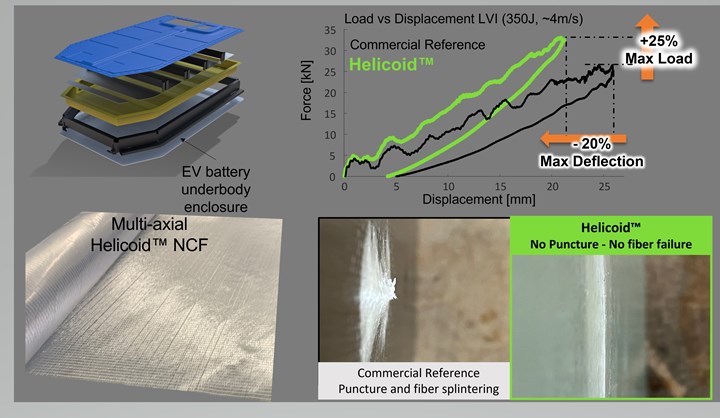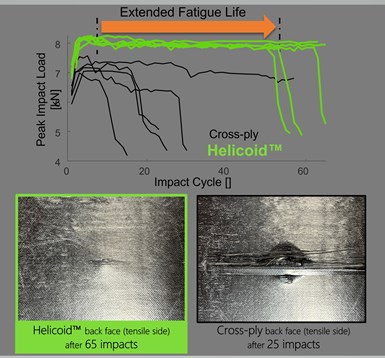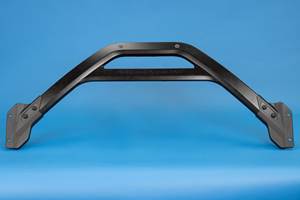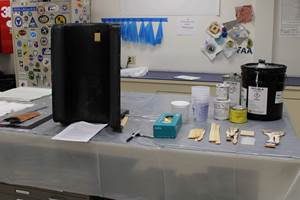Helicoid Industries releases three use cases of Helicoid technology
Use case applications with Helicoid technology implementation demonstrated mechanical performance improvements, such as impact resistance and strength.
Electric vehicle (EV) underbody enclosure use case and results. Photo Credit, all images: Helicoid Industries
Helicoid Industries Inc. (Indio, Calif., U.S.) successfully released three use cases highlighting its Helicoid technology at this year’s CAMX. The bio-inspired solution enables improved performance of advanced composites, leading to lighter structures, while achieving high cost efficiency and sustainability. According to the company, the deployment of Helicoid can be realized with no change in raw materials (fiber and resin), and no change in the manufacturing process (see “Creating stronger composites through nature-inspired, Helicoid designs”).
The first use case was a collaboration between Helicoid Industries Inc., TPI Composites Inc. (Scotsdale, Ariz., U.S.) and Saertex GmbH (Saerbeck, Germany) focusing on improving the mechanical performance of electric vehicle (EV) battery pack underbody protection plates made of E-glass Helicoid multiaxial noncrimp fabrics (NCFs) infused with a thermoset resin.
Key mechanical requirements of EV protective enclosures (more on this topic, see Part 1 and Part 2) are mainly tailored to resist road impact with the objective of guaranteeing the survivability and integrity of the battery module. Specifically, these requirements include resistance to perforation, reduction of fiber splintering (i.e., high structural integrity) and reduction of deflection under impact.
Prototyping and testing with Helicoid have reportedly demonstrated a 25% higher impact strength and a 20% reduction in the maximum deflection during impact compared to a commercial design at equal weight, using the same fiber type and resin system. These results were primarily achieved by engineering the ply angles of the glass fibers from a conventional quasi-isotropic layup to the company’s bio-inspired helicoidal layup with tailored stiffness and impact performance. Fiber failure was suppressed upon impact, thus leading to a solution with high structural integrity and potential for both weight and cost savings.
“Helicoid’s fiber architecture technology enables a viable solution for improving/optimizing impact performance,” Kevin Veloso, TPI Composites, Inc. principal engineer, transportation, says. “The delay in fiber damage makes the composite laminates more durable and impact resistant. It has been a pleasure collaborating with such great talent at Helicoid and look forward to our mutual success.”
“Natural fiber composite materials are key to achieving a more sustainable transportation industry. Biomimicry can be an effective tool to enable a more extensive use of natural fiber composite products in high-performance applications and load-bearing structures.”
The second use case demonstrated that Helicoid fiber architecture delivers excellent performance improvements with fiber-reinforced thermoplastic composites. These materials are equally strong and stiff as thermoset composites, Helicoid Industries notes, but provide improved energy absorption, fatigue resistance and recyclability. They are also faster to process. These characteristics make the Helicoid technology ideally suitable for mass production.
In a collaboration with Mitsui Chemicals Europe GmbH (Düsseldorf, Germany), with the support of Airborne (The Hague, Netherlands), it was demonstrated that Tafnex carbon fiber/PP laminates, using the Helicoid fiber architecture technology achieves >90% higher multi-strike resistance compared to conventional laminate designs. This, along with the healing enabled by Helicoid fiber architectures and thermoplastic matrix systems, paves the way for improved cost efficiency and sustainability by achieving “more with less,” Helicoid Industries notes.
The company’s paper, “Bioinspired Helicoid Architectures for High-Performance Sustainable Composites: From Sporting Goods to Automotive Applications,” won the CAMX 2022 Outstanding Technical Paper Award. Authored by Dr. Lorenzo Mencattelli, Helicoid Industries managing director of technology and operations, it highlights the third use case, describing how natural fiber composites can now be used successfully, where historically they have struggled to find market share in high-volume, high-performance applications for their relatively low performance/cost ratio.
In a collaboration with National University of Singapore (NSU), Helicoid Industries has demonstrated that the Helicoid technology can be successfully tailored to enhance impact performance of a wide set of natural fiber composites and their hybrids. The study included an in-depth analysis of several Helicoid configurations including flax/glass fiber composite hybrids with different flax/glass fiber ratios. Key achievements include the demonstration that Helicoid can outperform 100% glass fiber composites while using 50% of its mass with natural flax fibers, which have a >50% lower carbon footprint. Key performance improvements included +60% larger “warning region” before failure, +105% energy storage before peak load, +32% perforation energy and +14% impact strength.
According to Dr. Mencattelli, “Natural fiber composite materials are key to achieving a more sustainable transportation industry. Biomimicry can be an effective tool to enable a more extensive use of natural fiber composite products in high-performance applications and load-bearing structures (see “Drawing design cues from nature: Designing for biomimetic composites, Part 1”). The collaboration with NSU has demonstrated how Helicoid technology can be efficiently shaped to deliver meaningful margins of improvement for both high-end products using natural fibers UD [unidirectional] tape prepreg systems and high-volume applications using flax NCF and a liquid molding process, thus creating an opportunity for technology deployment in a wide range of markets and applications.”
Related Content
CirculinQ: Glass fiber, recycled plastic turn paving into climate solutions
Durable, modular paving system from recycled composite filters, collects, infiltrates stormwater to reduce flooding and recharge local aquifers.
Read MoreAutomotive chassis components lighten up with composites
Composite and hybrid components reduce mass, increase functionality on electric and conventional passenger vehicles.
Read MoreFostering best practices for wet layup procedures
As fabricators continue to manufacture composite tools and parts using an open mold, wet layup process — often with mixed success — it’s important to stress proper preparation, materials, application methods and standardization.
Read MoreJEC World 2022, Part 3: Emphasizing emerging markets, thermoplastics and carbon fiber
CW editor-in-chief Jeff Sloan identifies companies exhibiting at JEC World 2022 that are advancing both materials and technologies for the growing AAM, hydrogen, automotive and sustainability markets.
Read MoreRead Next
Composites end markets: Energy (2024)
Composites are used widely in oil/gas, wind and other renewable energy applications. Despite market challenges, growth potential and innovation for composites continue.
Read MoreCW’s 2024 Top Shops survey offers new approach to benchmarking
Respondents that complete the survey by April 30, 2024, have the chance to be recognized as an honoree.
Read MoreFrom the CW Archives: The tale of the thermoplastic cryotank
In 2006, guest columnist Bob Hartunian related the story of his efforts two decades prior, while at McDonnell Douglas, to develop a thermoplastic composite crytank for hydrogen storage. He learned a lot of lessons.
Read More




























